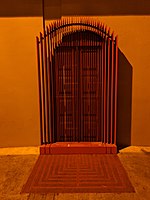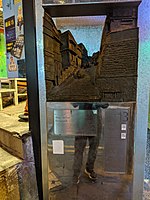Dr Sun Yat-sen Historical Trail

The Dr Sun Yat-sen Historical Trail (Chinese: 孫中山史蹟徑) was set up in November 1996 by the Central and Western District Council to commemorate the 130th birthday of Sun Yat-sen. It includes 16 spots in the areas of Central and Sheung Wan in Hong Kong, related to the life of Sun Yat-sen and other revolutionaries in the late Qing era. Originally the Sun Yat-sen Historical Trail had 13 markers; in 2001, it was renovated and renamed, and two spots (now the 1st and the 7th spots) were added to it.[1] In 2018, the trail was further updated under a Revitalization Project, where artists were commissioned by the government to create art at each location.[2]
There are multiple bronze markers embedded in sidewalks and handrails throughout the city, noting the trail. Although about 600m north of the trail, the Sun Yat Sen Memorial Park in Sai Ying Pun contains a large concrete map of the trail near its main gate. The Dr Sun Yat-sen Museum was opened in 2006 and is about 200m south of the trail.
| Name | Notes/Location | Photographs | Significance | References |
|---|---|---|---|---|
| 1 - The University of Hong Kong | Bonham Road |  |
Founded in 1911, the University of Hong Kong (HKU) is the city's oldest higher education institution. Sun Yat-sen studied at the College of Medicine for Chinese, Hongkong, from 1887 to 1892. This institution later became part of HKU’s Faculty of Medicine in 1912. Sun Yat-sen returned to HKU on February 20, 1923, where he delivered a speech describing Hong Kong and the university as his "intellectual birthplace." |
[3] |
| 2 - Original site of the Diocesan Home and Orphanage | Eastern Street |  |
Before pursuing his medical studies, Sun Yat-sen briefly attended the Diocesan Home and Orphanage in late 1883. Founded by the Anglican Church, the school provided Western-style education to Chinese students. Sun later transferred to Government Central School in April 1884, marking an essential step in his academic journey. | [5][6] |
| 3 - Original site of Tong Meng Hui Reception Centre | Po Hing Fong |  |
Founded by Sun Yat-sen in 1905, the Tongmenghui’s Hong Kong branch established reception centers, including one at Po Hing Fong. These served as safe havens for revolutionaries and supported anti-Qing government activities. | [7][8] |
| 4 - Original site of the American Congregational Mission Preaching Hall | 2 Bridges Street (now Bridges Street Market) |  |
After arriving in Hong Kong, Sun Yat-sen lived at the American Congregational Mission Preaching Hall. He was baptized there and adopted the Christian name "Yat-sen." After transferring to the Government Central School, he continued to reside at the preaching hall. | [9] |
| 5 - Original site of the Government Central School | 44 Gough Street |  |
Founded in 1862, the Government Central School was Hong Kong’s first public school with a Western curriculum. Sun Yat-sen enrolled in 1884 and graduated in 1886. | [11] |
| 6 - Original site of the "Yeung Yiu Kee", meeting Place for "the Four Bandits" | 8 Gough Street (marker located at intersection of Gough Street and Shin Hing Street) |  |
While studying medicine, Sun Yat-sen met with friends at Yeung Yiu Kee on Gough Street to discuss politics and the anti-Qing cause. The group, known as the ‘Four Great Outlaws,’ held views considered radical at the time. |
[13] |
| 7 - Site where Yeung Ku-wan was assassinated by Qing agents | 52 Gage Street, corner of Aberdeen Street. The marker has been moved into Sam Ka Lane in Pak Tsz Lane Park, at the rear of 52 Gage Street. |  |
Yeung Ku-wan, president of the Hong Kong branch of the Revive China Society, was assassinated in January 1901. The Qing government sent an assassin after Yeung’s failed uprisings in Guangzhou and Huizhou. | [15] |
| 8 - Original site of the Furen Literary Society | Pak Tsz Lane |  |
Founded in 1892 by Yeung Ku-wan and Tse Tsan-tai, Foo Yan Man Ser at 1 Pak Tsz Lane focused on political discussions and reforms. Sun Yat-sen had close ties with its members, including Yeung and Tse, who later played key roles in the Revive China Society. | [17] |
| 9 - Original site of the Queen's College | Between Aberdeen Street and Hollywood Road. Markers in Hollywood Road and Staunton Street, along the walls of the Former Hollywood Road Police Married Quarters. |  |
The foundation stone of the new Government Central School was laid on 26 April 1884, likely attended by Sun Yat-sen. The school became Victoria College in 1889 and Queen's College in 1894. In 1950, it moved to Causeway Bay, and the original site is now PMQ. | [19] |
| 10 - Original site of the Alice Memorial Hospital & the College of Medicine for Chinese, Hong Kong | 77 to 81 Hollywood Road |  |
Sun Yat-sen studied at the College of Medicine for Chinese, Hong Kong, after transferring from the Canton Hospital in 1887. He graduated in 1892, and the college became part of the University of Hong Kong's Faculty of Medicine in 1912. | [21] |
| 11 - Original site of the To Tsai Church | 75 Hollywood Road |  |
While studying medicine in Hong Kong, Sun Yat-sen lived at the College of Medicine for Chinese and often attended gatherings at To Tsai Church nearby. It was here that he built the network that would later support his revolutionary efforts. Both the church and Alice Memorial Hospital were founded by the London Missionary Society to aid the local Chinese community. | [23] |
| 12 - Original site of the Hong Kong Headquarters of Revive China Society | 13 Staunton Street |  |
In February 1895, Sun Yat-sen established the Hong Kong Headquarters of the Revive China Society at 13 Staunton Street, disguised as the Kuen Hang Club. The headquarters, led by Wong Wing-sheung, organized the first revolutionary attempt, the Guangzhou uprising. | [25] |
| 13 - Original site of the Heng Yin Lau Western Restaurant | 2 Lyndhurst Terrace |  |
Heng Yin Lau, a popular Western-style restaurant in late 19th-century Hong Kong, was located at the intersection of Lyndhurst Terrace and Pottinger Street. It was a favored meeting spot for Sun Yat-sen and his friends to discuss national affairs during his medical studies. | [27] |
| 14 - Original site of the China Daily Office | 24 Stanley Street (marker located at 19 Stanley Street) |  |
In 1899, Sun Yat-sen instructed Chan Siu-pak to establish The China Daily in Hong Kong as anti-Qing propaganda. The office, which opened in January 1900, was not only the publication site but also a meeting point for Revive China Society members and revolutionaries. The Huizhou uprising in 1900 was planned on the office's second floor. | [29] |
| 15 - Original site of Wo Kee Chan | 20 D'Aguilar Street (marker located at 24 Wellington Street) |  |
Wo Kee Chan, a seamen’s boarding house on the third floor of 20 D'Aguilar Street, was used as a base for revolutionary activities. It was here that the 1903 Guangzhou uprising was planned, led by Tse Tsan-tai and financially supported by Li Ki-tong. The uprising ultimately failed, and Tse later founded South China Morning Post to promote reform and revolution. | [31] |
| 16 - Hong Kong in the Time of Dr Sun Yat-sen | Intersection of Staunton Street and Shing Wong Street; is located close to spot #4. |  |
[33] | |
| Example of bronze sidewalk marker | Intersection of Staunton Street and Graham Street |  |
||
| Example of handrails | Shing Wong Street, between Staunton Street / Bridges Street and Hollywood Road |  |
||
| Concrete map at Sun Yat Sen Memorial Park | Sun Yat Sen Memorial Park |  |
||
| Information Poster | Central-Mid-levels escalator |  |
||
| Information Poster | Central-Mid-levels escalator |  |
||
| Direction Pole | Intersection of Gage and Cochrane Street |  |
See also
[edit]- Heritage Trails in Hong Kong
- Dr Sun Yat-sen Museum, near the trail
- Sun Yat Sen Memorial Park
- Red House (Hong Kong)
References
[edit]- ^ "Little left to see on HK's Sun Yat-sen historical trail". South China Morning Post. 9 October 2011. Retrieved 2020-05-03.
- ^ "Revitalised Dr Sun Yat-sen Historical Trail becomes Hong Kong's latest cultural attraction (with photos)". www.info.gov.hk. Retrieved 2020-05-03.
- ^ "Dr Sun Yat-sen Historical Trail". .hku.hk. 1923-02-20. Archived from the original on 2012-03-14. Retrieved 2012-04-03.
- ^ https://www.discoverhongkong.com/us/explore/culture/dr-sun-yat-sen-historical-trail.html
- ^ "Leisure and Cultural Services Department - Antiquities and Monuments Office". Lcsd.gov.hk. 2011-11-24. Archived from the original on 2012-10-12. Retrieved 2012-04-03.
- ^ https://www.discoverhongkong.com/us/explore/culture/dr-sun-yat-sen-historical-trail.html
- ^ "Leisure and Cultural Services Department - Antiquities and Monuments Office". Amo.gov.hk. 2011-11-24. Retrieved 2012-04-03.
- ^ https://www.discoverhongkong.com/us/explore/culture/dr-sun-yat-sen-historical-trail.html
- ^ "Leisure and Cultural Services Department - Antiquities and Monuments Office". Amo.gov.hk. 2011-11-24. Retrieved 2012-04-03.
- ^ https://www.discoverhongkong.com/us/explore/culture/dr-sun-yat-sen-historical-trail.html
- ^ "Leisure and Cultural Services Department - Antiquities and Monuments Office". Amo.gov.hk. 2011-11-24. Retrieved 2012-04-03.
- ^ https://www.discoverhongkong.com/us/explore/culture/dr-sun-yat-sen-historical-trail.html
- ^ "Leisure and Cultural Services Department - Antiquities and Monuments Office". Amo.gov.hk. 2011-11-24. Retrieved 2012-04-03.
- ^ https://www.discoverhongkong.com/us/explore/culture/dr-sun-yat-sen-historical-trail.html
- ^ "Leisure and Cultural Services Department - Antiquities and Monuments Office". Amo.gov.hk. 2011-11-24. Retrieved 2012-04-03.
- ^ https://www.discoverhongkong.com/us/explore/culture/dr-sun-yat-sen-historical-trail.html
- ^ "Leisure and Cultural Services Department - Antiquities and Monuments Office". Amo.gov.hk. 2011-11-24. Retrieved 2012-04-03.
- ^ https://www.discoverhongkong.com/us/explore/culture/dr-sun-yat-sen-historical-trail.html
- ^ "Leisure and Cultural Services Department - Antiquities and Monuments Office". Amo.gov.hk. 2011-11-24. Retrieved 2012-04-03.
- ^ https://www.discoverhongkong.com/us/explore/culture/dr-sun-yat-sen-historical-trail.html
- ^ "Leisure and Cultural Services Department - Antiquities and Monuments Office". Amo.gov.hk. 2011-11-24. Retrieved 2012-04-03.
- ^ https://www.discoverhongkong.com/us/explore/culture/dr-sun-yat-sen-historical-trail.html
- ^ "Leisure and Cultural Services Department - Antiquities and Monuments Office". Amo.gov.hk. 2011-11-24. Retrieved 2012-04-03.
- ^ https://www.discoverhongkong.com/us/explore/culture/dr-sun-yat-sen-historical-trail.html
- ^ "Leisure and Cultural Services Department - Antiquities and Monuments Office". Amo.gov.hk. 2011-11-24. Retrieved 2012-04-03.
- ^ https://www.discoverhongkong.com/us/explore/culture/dr-sun-yat-sen-historical-trail.html
- ^ "Leisure and Cultural Services Department - Antiquities and Monuments Office". Amo.gov.hk. 2011-11-24. Retrieved 2012-04-03.
- ^ https://www.discoverhongkong.com/us/explore/culture/dr-sun-yat-sen-historical-trail.html
- ^ "Leisure and Cultural Services Department - Antiquities and Monuments Office". Amo.gov.hk. 2011-11-24. Retrieved 2012-04-03.
- ^ https://www.discoverhongkong.com/us/explore/culture/dr-sun-yat-sen-historical-trail.html
- ^ "Leisure and Cultural Services Department - Antiquities and Monuments Office". Amo.gov.hk. 2011-11-24. Retrieved 2012-04-03.
- ^ https://www.discoverhongkong.com/us/explore/culture/dr-sun-yat-sen-historical-trail.html
- ^ "Hong Kong in the Time of Dr Sun Yat-sen". 孫中山史蹟徑. 2018-01-16. Retrieved 2020-01-30.
External links
[edit]- Brochures of the Dr Sun Yat-sen Historical Trail (.pdf documents): brochure part 1, brochure part 2, leaflet, map
22°16′56″N 114°09′04″E / 22.28221°N 114.15110°E
